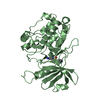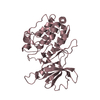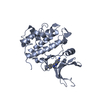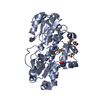[English] 日本語
 Yorodumi
Yorodumi- PDB-6fha: Death-associated Protein Kinase 1 (DAPK1) catalytic and auto-regu... -
+ Open data
Open data
- Basic information
Basic information
| Entry | Database: PDB / ID: 6fha | ||||||
|---|---|---|---|---|---|---|---|
| Title | Death-associated Protein Kinase 1 (DAPK1) catalytic and auto-regulatory domains with S289A and S308A mutations | ||||||
 Components Components | Death-associated protein kinase 1 DAPK1 DAPK1 | ||||||
 Keywords Keywords |  SIGNALING PROTEIN / SIGNALING PROTEIN /  kinase / kinase /  apoptosis / apoptosis /  autophagy / autophagy /  CaMK CaMK | ||||||
| Function / homology |  Function and homology information Function and homology informationcellular response to hydroperoxide / regulation of response to tumor cell / positive regulation of autophagic cell death / DAPK1-calmodulin complex / defense response to tumor cell / Caspase activation via Dependence Receptors in the absence of ligand /  syntaxin-1 binding / syntaxin-1 binding /  regulation of NMDA receptor activity / calmodulin-dependent protein kinase activity / positive regulation of cysteine-type endopeptidase activity involved in apoptotic process ...cellular response to hydroperoxide / regulation of response to tumor cell / positive regulation of autophagic cell death / DAPK1-calmodulin complex / defense response to tumor cell / Caspase activation via Dependence Receptors in the absence of ligand / regulation of NMDA receptor activity / calmodulin-dependent protein kinase activity / positive regulation of cysteine-type endopeptidase activity involved in apoptotic process ...cellular response to hydroperoxide / regulation of response to tumor cell / positive regulation of autophagic cell death / DAPK1-calmodulin complex / defense response to tumor cell / Caspase activation via Dependence Receptors in the absence of ligand /  syntaxin-1 binding / syntaxin-1 binding /  regulation of NMDA receptor activity / calmodulin-dependent protein kinase activity / positive regulation of cysteine-type endopeptidase activity involved in apoptotic process / extrinsic apoptotic signaling pathway via death domain receptors / positive regulation of autophagy / regulation of NMDA receptor activity / calmodulin-dependent protein kinase activity / positive regulation of cysteine-type endopeptidase activity involved in apoptotic process / extrinsic apoptotic signaling pathway via death domain receptors / positive regulation of autophagy /  regulation of autophagy / apoptotic signaling pathway / cellular response to type II interferon / regulation of autophagy / apoptotic signaling pathway / cellular response to type II interferon /  actin cytoskeleton / regulation of apoptotic process / protein autophosphorylation / actin cytoskeleton / regulation of apoptotic process / protein autophosphorylation /  postsynaptic density / negative regulation of translation / postsynaptic density / negative regulation of translation /  calmodulin binding / calmodulin binding /  non-specific serine/threonine protein kinase / non-specific serine/threonine protein kinase /  protein kinase activity / intracellular signal transduction / positive regulation of apoptotic process / protein kinase activity / intracellular signal transduction / positive regulation of apoptotic process /  protein phosphorylation / protein serine kinase activity / protein serine/threonine kinase activity / glutamatergic synapse / apoptotic process / GTP binding / negative regulation of apoptotic process / protein phosphorylation / protein serine kinase activity / protein serine/threonine kinase activity / glutamatergic synapse / apoptotic process / GTP binding / negative regulation of apoptotic process /  ATP binding / identical protein binding / ATP binding / identical protein binding /  nucleus / nucleus /  plasma membrane / plasma membrane /  cytoplasm cytoplasmSimilarity search - Function | ||||||
| Biological species |   Homo sapiens (human) Homo sapiens (human) | ||||||
| Method |  X-RAY DIFFRACTION / X-RAY DIFFRACTION /  SYNCHROTRON / SYNCHROTRON /  MOLECULAR REPLACEMENT / Resolution: 2.3 Å MOLECULAR REPLACEMENT / Resolution: 2.3 Å | ||||||
 Authors Authors | Huart, A.-S. / Wilmanns, M. | ||||||
 Citation Citation |  Journal: To Be Published Journal: To Be PublishedTitle: Molecular mechanisms behind DAPK regulation: how phosphorylation switches work Authors: Huart, A.-S. / Simon, B. / Lubner, J. / Mertens, H.D.T. / Temmerman, K. / Hoffmann, J.-E. / Svergun, D.I. / Schwartz, D. / Schultz, C. / Wilmanns, M. | ||||||
| History |
|
- Structure visualization
Structure visualization
| Structure viewer | Molecule:  Molmil Molmil Jmol/JSmol Jmol/JSmol |
|---|
- Downloads & links
Downloads & links
- Download
Download
| PDBx/mmCIF format |  6fha.cif.gz 6fha.cif.gz | 74.6 KB | Display |  PDBx/mmCIF format PDBx/mmCIF format |
|---|---|---|---|---|
| PDB format |  pdb6fha.ent.gz pdb6fha.ent.gz | 53.7 KB | Display |  PDB format PDB format |
| PDBx/mmJSON format |  6fha.json.gz 6fha.json.gz | Tree view |  PDBx/mmJSON format PDBx/mmJSON format | |
| Others |  Other downloads Other downloads |
-Validation report
| Arichive directory |  https://data.pdbj.org/pub/pdb/validation_reports/fh/6fha https://data.pdbj.org/pub/pdb/validation_reports/fh/6fha ftp://data.pdbj.org/pub/pdb/validation_reports/fh/6fha ftp://data.pdbj.org/pub/pdb/validation_reports/fh/6fha | HTTPS FTP |
|---|
-Related structure data
| Related structure data |  6fhbC  6qmoC  6qn4C  4b4lS  6fh9 S: Starting model for refinement C: citing same article ( |
|---|---|
| Similar structure data |
- Links
Links
- Assembly
Assembly
| Deposited unit | 
| ||||||||
|---|---|---|---|---|---|---|---|---|---|
| 1 |
| ||||||||
| Unit cell |
|
- Components
Components
| #1: Protein |  DAPK1 / DAP kinase 1 DAPK1 / DAP kinase 1Mass: 38647.332 Da / Num. of mol.: 1 / Mutation: S289A S308A Source method: isolated from a genetically manipulated source Details: h / Source: (gene. exp.)   Homo sapiens (human) / Gene: DAPK1, DAPK / Production host: Homo sapiens (human) / Gene: DAPK1, DAPK / Production host:   Escherichia coli (E. coli) Escherichia coli (E. coli)References: UniProt: P53355,  non-specific serine/threonine protein kinase non-specific serine/threonine protein kinase |
|---|---|
| #2: Water | ChemComp-HOH /  Water Water |
-Experimental details
-Experiment
| Experiment | Method:  X-RAY DIFFRACTION / Number of used crystals: 1 X-RAY DIFFRACTION / Number of used crystals: 1 |
|---|
- Sample preparation
Sample preparation
| Crystal | Density Matthews: 2.38 Å3/Da / Density % sol: 48.4 % / Description: cuboid |
|---|---|
Crystal grow | Temperature: 292.15 K / Method: vapor diffusion, sitting drop Details: 22% PEG 4000, 0.2M ammonium sulfate, 0.1M sodium sulfate |
-Data collection
| Diffraction | Mean temperature: 100 K |
|---|---|
| Diffraction source | Source:  SYNCHROTRON / Site: SYNCHROTRON / Site:  PETRA III, EMBL c/o DESY PETRA III, EMBL c/o DESY  / Beamline: P14 (MX2) / Wavelength: 1.0332 Å / Beamline: P14 (MX2) / Wavelength: 1.0332 Å |
| Detector | Type: DECTRIS PILATUS 6M-F / Detector: PIXEL / Date: Nov 8, 2016 / Details: Toroidal mirror |
| Radiation | Monochromator: Si(111) / Protocol: SINGLE WAVELENGTH / Monochromatic (M) / Laue (L): M / Scattering type: x-ray |
| Radiation wavelength | Wavelength : 1.0332 Å / Relative weight: 1 : 1.0332 Å / Relative weight: 1 |
| Reflection | Resolution: 1.878→39.943 Å / Num. obs: 25549 / % possible obs: 91.4 % / Redundancy: 4.9 % / Biso Wilson estimate: 35.977 Å2 / Rmerge(I) obs: 0.134 / Rpim(I) all: 0.067 / Rrim(I) all: 0.15 / Net I/σ(I): 8.9 |
| Reflection shell | Resolution: 1.88→1.95 Å / Redundancy: 2.9 % / Rmerge(I) obs: 0.705 / Num. unique all: 992 / CC1/2: 0.018 / % possible all: 36.1 |
- Processing
Processing
| Software |
| ||||||||||||||||||||||||||||||||||||||||||
|---|---|---|---|---|---|---|---|---|---|---|---|---|---|---|---|---|---|---|---|---|---|---|---|---|---|---|---|---|---|---|---|---|---|---|---|---|---|---|---|---|---|---|---|
| Refinement | Method to determine structure : :  MOLECULAR REPLACEMENT MOLECULAR REPLACEMENTStarting model: 4B4L Resolution: 2.3→39.943 Å / SU ML: 0.29 / Cross valid method: FREE R-VALUE / σ(F): 1.34 / Phase error: 26.58
| ||||||||||||||||||||||||||||||||||||||||||
| Solvent computation | Shrinkage radii: 0.9 Å / VDW probe radii: 1.11 Å | ||||||||||||||||||||||||||||||||||||||||||
| Refinement step | Cycle: LAST / Resolution: 2.3→39.943 Å
| ||||||||||||||||||||||||||||||||||||||||||
| Refine LS restraints |
| ||||||||||||||||||||||||||||||||||||||||||
| LS refinement shell |
|
 Movie
Movie Controller
Controller












 PDBj
PDBj








